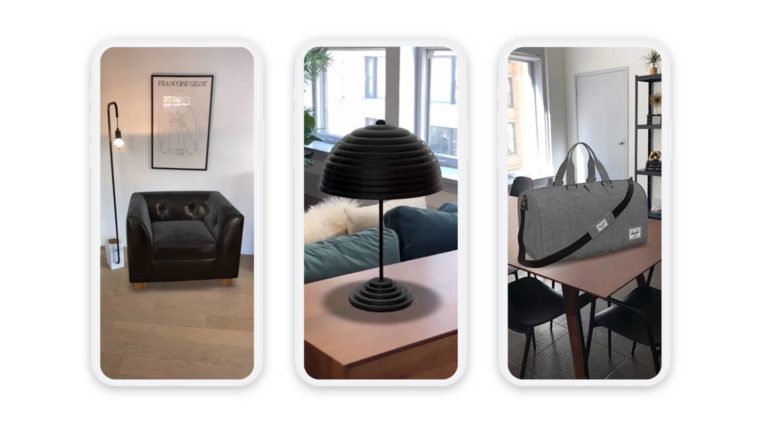
Among AR use cases showing consumer traction and a real business case, immersive shopping is an early standout. We’re talking about AR experiences that help consumers visualize and contextualize products through their smartphone camera before they purchase.
This is what we call camera commerce and its advantages include bringing more visual context and confidence to consumer purchase decisions. This has been amplified in the Covid era as it brings dimension to eCommerce, thereby piggybacking on online shopping inflections.
This is the topic of a recent ARtillery Intelligence report (AR Insider’s research arm), including market size estimates, narrative analysis and case studies. It’s also the topic of the latest episode of ARtillery Briefs, which you can see below in embedded video and summarized takeaways.
Two Flavors
Camera commerce mostly plays out in two ways: product visualization and visual search. The former involves remotely simulating commercial items on ‘faces and spaces’ while the latter is all about pointing your phone at nearby products to get information on – or purchase – them.
Another way to look at these AR shopping modalities is that product visualization is done remotely and in eCommerce contexts, while visual search is done in proximity to products that are in view. This makes visual search more conducive to retail shopping and real-world discovery.
Another difference between these two flavors of AR shopping is that product visualization has gained earlier traction due to its use in social lenses. But visual search could gain ground due to its high-intent use case (much like web search) to actively seek information about products.
Collectively, ARtillery projects these AR shopping use cases to drive $58 billion in consumer purchases by 2025. To define this figure, it measures the transaction value of hard goods whose sale was influenced in some way through AR (though it isn’t counted as “AR revenue” per se).
Visually Informed
Going deeper on product visualization, it’s become a popular among consumers to qualify buying decisions; and among brands to boosts sales. The latter involves higher conversions and fewer returns, both of which result from purchase decisions that are more visually informed.
We project this to gain value as it continues to expand to the rear-facing camera to augment the broader canvas of the physical world, as opposed to selfie-based AR which is limited to the products that can go on one’s face. Snap and other AR leaders are moving in this direction.
As for visual search, it continues to gain traction as a way to visually identify unknown items. Google is leading the way, not surprisingly, starting with general-interest subjects like pets and flowers. But the real opportunity will be with commercial products such as fashion items.
Beyond Google, Pinterest shows promise in visual search because of its visual shopping persona. Snap Scan is also developing visual-search use cases that utilizes AI and data from partners in different product categories – recently amplified through food and style integrations.
Looming Question
As for distribution channels, camera commerce takes place in a variety of consumer touchpoints, the most prevalent today being social apps like Snapchat. But we’re bullish on web AR to emerge as an AR shopping channel, due to its lack of friction and greater device compatibility.
Meanwhile, one bottleneck is 3D product models. Creation workflows are rigorous, making it difficult to scale asset production. File size is an issue on mobile devices, so compression and optimization technologies will be valuable enablers as this value chain develops.
Lastly, a looming question is if camera commerce has a prominent place in the post-Covid world. It has piggybacked on Covid-era eCommerce inflections but will that sustain? As noted, visual search could support in-aisle retail shopping, not to mention “touchless” interactions.
Will that resonate among consumers after Covid recedes? And will AR shopping’s elevated exposure over the past 18 months translate to long-term adoption? These are questions that will be answered in the coming months, and we’ll be tracking relevant signals closely.
Meanwhile, see the full AR briefs episode below and the report it was based on here…






